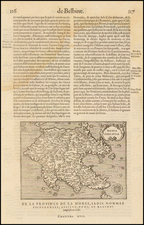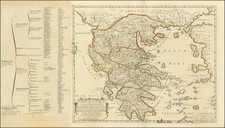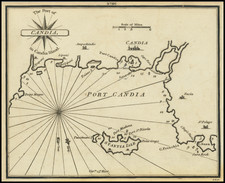Fine Image of the City Gates of Rhodes, from the Nuremberg Chronicle
Striking view of one of the city gates of the city of Rhodes, from the famous Nuremberg Chronicle. The Chronicle featured many city illustrations, some of which were the first printed images of those places.
The image shows a portion of the city wall, with a tower block, and several higher buildings clustered nearby.
Published in 1493, the Chronicle was made during the occupation of Rhodes by the Knights of St. John, also known as the Knights Hospitaler or the Knights of Malta. Located on the largest of the Dodecanese islands in the southeastern Aegean Sea, the Knights ruled there from 1310 to 1522.
Rhodes has been inhabited since prehistorical times, with Neolithic, Minoan, and Mycenaean settlements remains and artifacts. The island joined the Athenian League in the fifth century BCE, was taken by the Persians twice, and then became part of Alexander the Great’s Greece.
After the split caused by Alexander’s death, one of his generals, Antigonus, ordered his son, Demetrius, to besiege Rhodes. He came with massive siege engines, but gave in after a year. He left behind the massive military equipment, which the Rhodians sold. They used the proceeds to commission a massive statue of the sun god, Helios, better known as the Colossus of Rhodes, one of the seven wonders of the ancient world.
Rhodes was independent for a time before being folded into the Roman Empire in 164 BCE. In the fourth century CE, it became part of the Byzantine Empire. They were not left in peace, with occupations by the Sasanians, Umayyads (who carted away the remains of the Colussus), and the Arabs in the seventh century CE. Later, the Seljuk Turks invaded in ca. 1090, although the island was retaken in the First Crusade. In the early thirteenth century, the island and city became semi-independent, but then the Genoese briefly took over, followed by the Nicaeans.
This passing back and forth stopped in 1310, when the Knights of St. John made the island their stronghold following the loss of the Holy Land. They rebuilt much of the city, including the parts in the illustration seen here. They fortified the city walls, which were tested by attacks in 1444 and a siege in 1480. Suleman the Magnificent finally breached the defenses in 1522, forcing the Knights to surrender and withdraw, first to Sicily and then to their new base in Malta. Rhodes then remained an Ottoman possession for four centuries.
In the Nuremberg Chronicle, Rhodes is described as follows (folio XXVI verso):
Rhodes, the city on the island of Rhodes, off Lycia, from which it derived its name, was built in 740 B.C., in Joseph’s time, by the Telchines and Carians, who soon thereafter were conquered by Phoroneus, the king of Argira. It is one of the islands called the Cyclades for reasons known to the learned. Those who first came there from the East, while the city was being built (as Pomponius writes) and the ground was being dug up, found there a rosebud, after which the city and the island were called Rhodis; for, according to the Greek tongue, Rhodis means a rose. The island is 900 furlongs in circumference. Among other wonders it contained a statue 70 cubits high, built by Lindus, a disciple of Lisippus. The city suffered much through wars, and finally at the hands of the Turks. It was finally relieved and protected by the Order of the Kings of St. John.
Rhodes is the most easterly island of the Aegean, or more specifically, of the Carpathian Sea, and lies off the south coast of Caria. According to mythology it was first peopled by the Telchines, the children of Thalatta (the Sea). Homer mentions three Dorian settlements, namely, Lindus, Ialysus and Camirus, formed the Dorian Hexapolis, which was established from a period of unknown antiquity, in the southwest coast of Asia Minor. For centuries the island of Rhodes was the constant seat of war. During the Peloponnesian war, Rhodes was subject to Athens. Later it joined the Spartans. It was subjugated by Athens and Sparta in turn, till the end of the Social War of 355 BCE, when its independence was acknowledged. There were frequent internal dissensions. At the Macedonian conquest they submitted to Alexander, but upon his death expelled the Macedonia garrison.
The city of Rhodes, successfully endured the most famous siege by Demetrius Poliorcetes, who at length in admiration of the valor of the besieged, presented them with the engines he had used against them, from the sale of which they defrayed the cost of the celebrated Colossus by the artist Chares of Lindus in Rhodes, the favorite pupil of Lysippus, who flourished about 290 BCE. This, his chief work, a statue of the Sun, was celebrated as one of the Seven Wonders of the World, under the title "The Colossus of Rhodes." Its height was upwards of 105 feet, and it was twelve years in the making. It stood at the entrance of the harbor of Rhodes, but there is no authority for the statement that its legs extended over the mouth of the harbor. It was overthrown and broken to pieces by an earthquake 56 years after its erection in 224 BCE. The fragments remained on the ground 923 years, until they were sold by the general of the caliph Othman IV to a Jew of Emesa, who carried them away on 900 camels in 672 CE.
The Rhodians were at length deprived of their independence by the Roman Emperor Claudius, and their prosperity received its final blow from and earthquake which laid the city of Rhodes in ruins in 155 CE. In the Middle Ages Rhodes became the seat of the celebrated Knights of St. John.
Hartmann Schedel (1440-1514) was a physician, book collector, and writer whose most famous work, the Liber Chronicarum (Nuremberg Chronicle), included some of the first printed views of many cities in Europe and across the world.
Schedel was born and died in Nuremberg, but he also traveled for his education. From 1456 to 1463 he lived in Leipzig, where he attended the University of Leipzig and earned his MA. From there he went to Padua, where he earned a Doctor of Medicine in 1466. After university, he worked for a time in Nördlingen and then returned to Nuremberg. In 1482 he was elected a member of the Great Council of Nuremberg.
The Chronicle was published in 1493. Besides this major work, one of Schedel’s most enduring legacies is his magnificent manuscript and printed book collection, one of the largest of the fifteenth century. In 1552, Schedel's grandson, Melchior Schedel, sold about 370 manuscripts and 600 printed works from Hartmann Schedel's library to Johann Jakob Fugger. Fugger later sold his library to Duke Albert V of Bavaria in 1571. This library is now mostly preserved in the Bayerische Staasbibliothek in Munich.
Among the surviving portions of Schedel's library are the records for the publication of the Chronicle, including Schedel's contract with Anton Koberger for the publication of the work and the financing of the work by Sebald Schreyer and Sebastian Kammermeister, as well as the contracts with Wohlgemut and Pleydenwurff for the original artworks and engravings. The collection also includes original manuscript copies of the work in Latin and German.









![[Crete -- Land of Mythical Creatures and Greek Gods] Creta Insula Plerumq; Deum Natalibus., Iovis Incunabulis Sepulchroq: Inclyta: Adventu Europae, Minoe Ree; Pasiphaes et Ariadnae Amoribus; Minotauri Feritate,Fatoqu: Daedali Labryntho et Fuga; Multisq. alijs Famigerata Fabuili. Centum Urbibus Habitata; Quae Prima Ptuit Nauibus Satittis, Prima Litteris jura Iunxit. . . . M DC LXXVI](https://storage.googleapis.com/raremaps/img/small/82040.jpg)
![(First state!) [Greece & Turkey] Tabula Europae X](https://storage.googleapis.com/raremaps/img/small/94618.jpg)



